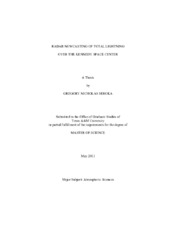| dc.description.abstract | The NASA Kennedy Space Center (KSC) is situated along the east coast of central Florida, where a high frequency of lightning occurs annually. Although cloud-to-ground (CG) lightning forecasting using radar echoes has been thoroughly analyzed, few studies have examined intracloud (IC) and/or total (IC CG) lightning. In addition to CG
lightning, IC flashes are of great concern to KSC launch operations.
Four years (2006-2009) of summer (June, July, August) daytime (about 14-00 Z) Weather Surveillance Radar – 1988 Doppler data for Melbourne, FL were analyzed. Convective cells were tracked using a modified version of the Storm Cell Identification and Tracking (SCIT) algorithm and then correlated to CG lightning data from the National
Lightning Detection Network (NLDN), as well as grouped IC flash data acquired from the KSC Lightning Detection and Ranging (LDAR) networks I and II. Pairs of reflectivity
values (30, 35, and 40 dBZ) at isothermal levels (-10, -15, -20 and updraft -10 degrees C), as well as a vertically integrated ice (VII) product were used to optimize criteria for radar-based forecasting of both IC and CG lightning within storms.
Results indicate that the best radar-derived predictor of CG lightning according to CSI was 25 dBZ at -20 degrees C, while the best reflectivity at isothermal predictor for IC was 25 dBZ at -15 degrees C. Meanwhile, the best VII predictor of CG lightning was the 30th percentile (0.840 kg m-2), while the best VII predictor of IC was the 5th percentile (0.143 kg m-2), or nearly 6 times lower than for CG!
VII at both CG and IC initiation was higher than at both CG and IC cessation. VII was also found to be lower at IC occurrence, including at initiation, than at CG occurrence. Seventy-six percent of cells had IC initiation before CG initiation; using the first IC flash
as a predictor of CG occurrence also statistically outperformed other predictors of CG lightning. Even though average lead time for using IC as a predictor of CG was only 2.4 minutes, when taking into account automation processing and radar scan time for the other methods, lead times are much more comparable. | en |


